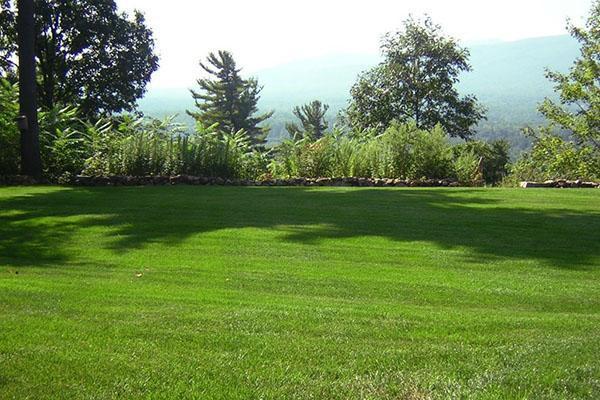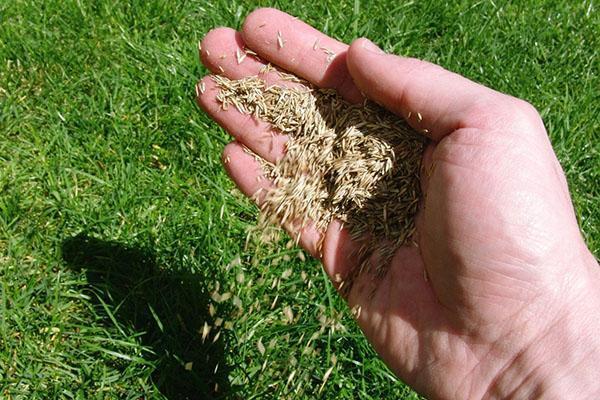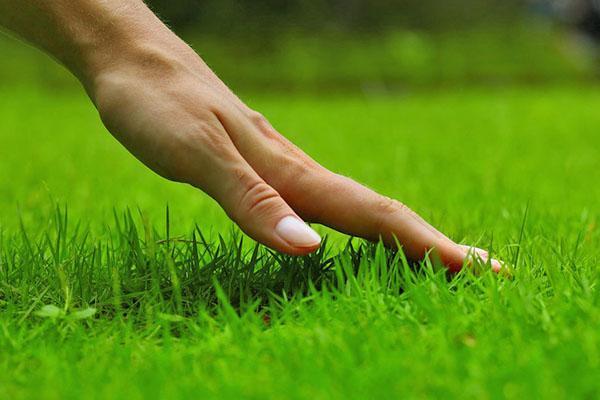Lawn grass: varieties and features of choice
 In an effort to save time and money, many homeowners are trying to create a lawn from existing vegetation. But no matter how much effort is invested, in such a situation it is not possible to achieve either the evenness of the coating, or its softness and durability.
In an effort to save time and money, many homeowners are trying to create a lawn from existing vegetation. But no matter how much effort is invested, in such a situation it is not possible to achieve either the evenness of the coating, or its softness and durability.
What is the secret of special grass mixtures for lawns, the sowing of which ensures friendly shoots and the formation of a dense green carpet, which retains its beauty for several years without much hassle? Obviously, the key lies in the selection of plants and the quality of grass seeds for the lawn, as well as in the proper care of the coating. How they approach the choice of plant species, and what properties such herbs should have, read in this article.
Necessary qualities of grass for a lawn

But of the whole mass of cereals, not all are suitable for sowing on a green lawn. To be part of a grass mixture for a lawn, a plant must meet a number of requirements:
- First of all, attention is paid to the decorative qualities of the grass, its softness and the ability to retain its color brightness for a long time.
- In the conditions of the middle zone, the frost resistance of the culture is extremely important.
- The best lawn grasses form an extensive root system that provides nutrition and development for plants on all types of soil.
- Plants to create a lawn should easily tolerate mowing by hand or lawn mowers and quickly recover from it.
Perennial grasses for the lawn predominate in the composition of specialized mixtures, which means that a year after sowing, the owner of the site will not have to renew the coverage.
The best species form a dense turf in one season, and the cover is renewed due to the formation of new shoots from existing plants.
Such a lawn takes care of itself. The roots of the grasses are so intertwined that they do not allow weed species to break through, and new ones quickly appear in the place of the dead rosettes. In addition, it is pleasant and safe to walk on a properly selected lawn; it tolerates unfavorable weather conditions and intensive use painlessly.
 When choosing grass seeds for a lawn, be sure to take into account:
When choosing grass seeds for a lawn, be sure to take into account:
- the purpose of the created coverage;
- climatic features of using the lawn;
- local natural factors such as lighting conditions, soil type, groundwater location and even planting area.
Today, grass mixtures for lawns include about two dozen plant species. But not all of them can withstand Russian operating conditions.
Types of perennial grasses for the lawn
Most often, varieties of bluegrass, bent grass and fescue are chosen as a seed crop. Mixes from major growers include ryegrass, hybrid grasses specially formulated for use on lawns, and other grasses that provide special qualities to greens.
How to choose from the existing variety for giving that grass for the lawn, which would decorate the site for many years?
 Among lawn grasses, meadow bluegrass is in the lead.This is a perennial herb, the height of which does not exceed 20 cm, and during the flowering period 80 cm.In Russia, the culture is easy to find not only on the lawn, but also in the wild, and the grass:
Among lawn grasses, meadow bluegrass is in the lead.This is a perennial herb, the height of which does not exceed 20 cm, and during the flowering period 80 cm.In Russia, the culture is easy to find not only on the lawn, but also in the wild, and the grass:
- prefers soil rich in humus;
- forms a powerful root system;
- not afraid of intensive walking on the green cover;
- early growing season;
- easily resists heat;
- recovers quickly after mowing.
This perennial lawn grass also has its drawback. The bluegrass coating does not show its full strength until one year after sowing.
If bluegrass is indicated among the grass seeds for the lawn, this means that the green cover will not suffer from the summer heat, will withstand shading and will not lose its decorative effect after a long period of rains.
Like bluegrass, various types of fescue are unpretentious cereals found everywhere in nature. Frost-resistant and drought-resistant red fescue is often used as grass for the lawn. The plant does not differ in its growth rate, but it feels great even on poorly nourished soils.
At the dacha, such an affordable and extremely unpretentious meadow timothy may well become a grass for a lawn. The cereal, typical for many regions of the Northern Hemisphere, reaches a height of 30–80 cm, quickly forms elastic rosettes pleasant to the touch, is inexpensive and very attractive.
 The bent borer is famous for the density of the cover formed and the ability to tolerate low mowing. The herb is beautiful in color, gets along well with other types of cereals and is resistant to a wide variety of weather conditions.
The bent borer is famous for the density of the cover formed and the ability to tolerate low mowing. The herb is beautiful in color, gets along well with other types of cereals and is resistant to a wide variety of weather conditions.
Before sowing grass for the lawn, you should carefully consider its properties. In the mixtures of foreign manufacturers, there are often cultures that are not able to provide the effect that they show at home.
An example is pasture ryegrass, which sometimes does not withstand Russian winters and dies at temperatures below –15 ° C and insufficient snow cover. As a result, already in the second season, the lush cover after sowing noticeably thinns.
Do not confuse meadow bluegrass with its annual relative. Fast growing lawn grass is propagated by seed only. In the first year, such a lawn will actively turn green, but with regular mowing it will not produce offspring and will lose its beauty after wintering. And such widespread grasses as sheep's fescue, turf pike and hedgehog are changed some time after sowing. landscape, forming noticeable bumps on a flat lawn.
Sowing one crop or grass mixture for the lawn?
 Since all plants, in addition to positive qualities, have weaknesses, to create a high-quality green coverage of the site, grass mixtures for lawns are often used, which, depending on the purpose and sowing conditions, can be subdivided:
Since all plants, in addition to positive qualities, have weaknesses, to create a high-quality green coverage of the site, grass mixtures for lawns are often used, which, depending on the purpose and sowing conditions, can be subdivided:
- on rapidly emerging, that is, allowing you to get a new cover in a minimum time or restore a lost one;
- on shade-tolerant, without loss of decorativeness and density of the cover, tolerating cultivation in the shade;
- drought tolerant, remaining attractive and fresh in bright sunlight and lack of moisture.
In universal lawn seed mixtures, the creators try to combine all the listed qualities and give the gardener the opportunity to get a decent result in any conditions.
As for the advertising promises that the mixture contains grass for the lawn that does not require a mowing, in most cases this is only slyness. No matter how stunted the cereals were, during the flowering period they throw out a peduncle, much higher than the foliage level.
Therefore, in order to preserve the external attractiveness and evenness of the cover, it is necessary, although not often mowed.Only such varieties of lawns as meadow and Moorish, where grains, perennial and annual flowering crops are found in free growth, are not mowed.
In order for the plants to show their best side, the seeds for the lawn must have a high germination rate, and the sowing is carried out evenly and in compliance with the accepted agricultural technology. Competent selection of the mixture allows you to emphasize the advantages of individual plants and neutralize their shortcomings so that the resulting lawn will be smoother and more beautiful in any weather, on any soil and with minimal maintenance.
Hello, thanks for the helpful information! True, we are engaged in wholesale purchases of rolled lawn, since we are a small private landscape studio, and I'm new, I don't understand everything, I was instructed to find a new supplier. But since I don't know much about a roll lawn, I began to look for information in order to understand how to determine a good lawn or not. You helped a lot!